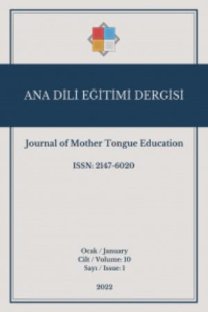Dördüncü Sınıf Öğrencilerin Akıcı Okumalarının Basit ve Çıkarımsal Anlama Düzeylerine Göre Değerlendirilmesi
Bu çalışmada 4. sınıf öğrencilerinin metin türlerine göre akıcı okuma ve okuduğunu anlama becerileri arasındaki ilişkiler incelenmiştir. Öğrencilerin hikâye edici ve bilgi verici metinlerde akıcı okumaları; hız, doğru okuma ve prozodi boyutlarında Yıldırım, Yıldız ve Ateş (2009) tarafından Türkçeye uyarlanan "Okuma Prozodisi Rubriği" ile değerlendirilmiştir. Okuduğunu anlama düzeyleri ise basit ve derinlemesine anlama olarak iki düzeyde ölçülmüştür. Basit anlama daha çok cevabı metin içinde bulunabilecek ve üst düzey zihinsel işlemleri gerektirmeyen soruları içermektedir. Derinlemesine anlama ise öğrencinin metindeki bilgileri kendi ön bilgileri ile ilişkilendirmesi, anlamlandırması ve yorumlamasını gerektirmektedir. Çalışmada basit ve derinlemesine anlamanın ölçülmesi amacıyla araştırmacılar tarafından geliştirilen okuduğunu anlama testi kullanılmıştır. Denizli il merkezinde orta sosyoekonomik düzeyde bir okulun 4. sınıflarından 100 öğrenci ile uygulamalar gerçekleştirilmiştir. Uygulamalarda her bir öğrenciye hikâye edici ve bilgi verici birer metin sesli olarak okutularak okumaları video kamera ile kaydedilmiş ve öğrenciler metinlerle ilgili okuduğunu anlama testlerini cevaplamışlardır. Uygulamalar her bir öğrenciyle ayrı ayrı yürütülmüştür. Video kayıtları kullanılarak öğrencilerin doğru okuma, okuma hızı ve prozodi becerileri değerlendirilmiştir. Veri toplama sürecinden sonra araştırma sorularına cevap olarak YEM analizleri gerçekleştirilmiş ve elde edilen bulgular doğrultusunda hem araştırmacılara hem de uygulayıcılara gerekli önerilerde bulunulmuştur
Evaluation of Fourth Grade Students' Reading Fluency Skills in Regard to Deep and Literal Comprehension Levels
The current research explored the relationships between reading fluency and reading comprehension skills of fourth grade students with regard to text types. The students' reading fluency skills including prosody, word recognition accuracy, and word recognition automaticity were assessed by using the rubric adapted into Turkish by Yıldırım, Yıldız and Ateş (2009). Reading comprehension skills of the students were assessed in regard to deep and literal levels. Whereas literal comprehension test included the questions, the answers of which can be found from the text inside, deep comprehension test required the students to combine their background knowledge with the information in the text inside. These comprehension levels were assessed by researcher-created comprehension tests. The current research sample consisted of a total of 100 fourth-grade students studying at a low socioeconomic public school in Turkey's Denizli province. After each student was asked to read narrative and expository texts aloud, all face to face sessions with the student were video recorded. Then, students' reading comprehension skills were assessed according to text types. By using video records, the students' reading prosody, accuracy and automaticity were scored. When the data gathering process was completed, the necessary analyses, such as SEM were used to figure out the answers in response to the research questions. Through the research findings, some practical profound implications were given for future researchers, practitioners, and policy makers in education system.
___
- Akyol, H. (2006). Türkçe Öğretim Yöntemleri . Ankara: Kök Yayıncılık
- Akyol, H., Yıldırım, K., Ateş, A. ve Çetinkaya, Ç., Rasinski, T. (2014). Okumayı değerlendirme . Ankara: Pegem A Yayınları.
- Akyol, M. (2014). Yapılandırılmış akıcı okuma yönteminin üçüncü sınıf öğrencilerinin akıcı okuma ile okuduğunu anlama becerilerine etkisi . Niğde: Niğde Üniversitesi, Ya yınlanmamış Yüksek Lisans Tezi.
- Başaran, M. (2013). Okuduğunu anlamanın bir göstergesi olarak akıcı okuma. Kuram ve Uygulamalarda Eğitim Bilimleri , 13, 2277 - 2290.
- Baştuğ, H.K. ve Akyol, H. (2012). Akıcı okuma becerilerinin okuduğunu anlamayı yordama düzeyi, Kuramsal Eğitimbilim Dergisi , 5 (4), 394 - 411
- Baştuğ, H.K. ve Kaman, Ş. (2013). Nörolojik etki yönteminin öğrencilerin akıcı okuma ve anlama becerilerine etkisi. Mehmet Akif Ersoy Üniversitesi Eğitim Fakültesi Dergisi, 13 , 291 - 309.
- Baştuğ, H.K. ve Keskin, M. (2012). Akıcı okuma becerileri ile anlama düzeyleri (basit ve çıkarımsal) ar asındaki ilişki. Ahi Evran Üniversitesi Kırşehir Eğitim Fakültesi Dergisi, 13, 227 - 244.
- Baştuğ, M. (2012). İlköğretim I. kademe öğrencilerinin akıcı okuma becerilerinin çeşitli değişkenler açısından incelenmesi . Ankara: Gazi Üniversitesi, Yayımlanmamış doktora tezi.
- Başusta, C.K. (2009). Okuma eğitiminde metin dil biliminin kullanımı (Yayınlanmamış yüksek lisans tezi). Afyon Kocatepe Üniversitesi, Afyonkarahisar
- Benjamin, G.R., & Schwanenflugel, P.J. (2010). Text complexity and oral reading prosody in yo ung readers. Reading Research Quarterly , 45, 388 - 404.
- Biancarosa, G., & Cummings, K., D. (2015). New metrics, measures, and uses for fluency data: An introduction to a special issue on the assessment of reading fluency. Read Writing, 28 , 1 - 7.
- Cain, K., & Oakhill, J.V. (1999). Inference making ability and its relation to comprehension failure in young children. Reading and Writing: An Interdisciplinary Journal, 11, 489 - 503.
- Cain, K., Oakhill, J.V., Barnes, M. A., & Bryant, P. E. (2001). Comprehension skill, inference - making ability, and their relation to knowledge. Memory & Cognition , 29(6), 850 - 859.
- Calet, N.,Defior, S., & Palma N.G. (2015). A cross - sectional study of fluency and reading comprehension in Spanish primary school children. Journal of Research in Reading , 38 (3), 272 - 285.
- ISSN: 2147-6020
- Yayın Aralığı: Yılda 4 Sayı
- Başlangıç: 2013
- Yayıncı: Mehmet Kurudayıoğlu
Sayıdaki Diğer Makaleler
Mini Kumbara Dergisi'nin Popüler Bilim Kaynakları Kapsamında Biçim ve İçerik Bakımından İncelenmes
Emine Damla TURAN, Elif KURT, NAZMİ ARSLAN
Okul Öncesi Öğretmenlerinin Türkçe Dil Etkinliklerine İlişkin Görüşleri: Lefkoşa Örneği
Emine ERAY ALIŞKAN, Ahmet Güneyli
Kurgusal Nitelikli Çocuk Kitapları ve Karakter Eğitimi
Ulus Karakteri ve Edebiyat: Ulus Karakterinin Edebi Ürünlerine Yansıması
